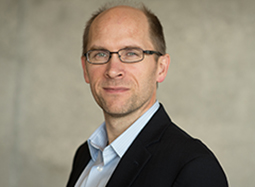Dr. Darren Moore leads a lab in Van Andel Research Institute’s Center for Neurodegenerative Science. His team is working to uncover the genetic causes of Parkinson’s, with the goal of developing targeted therapies for the disease.
VAI Voice had the opportunity to chat with Dr. Moore about his passion for science, his career, interests outside of work and his goals for the future.

Where did you grow up?
I grew up in Norwich, in the east of England.
What kind of a community is it? Industrial, urban or more of a farming area?
It’s more of a farming area; Norwich is a major city in the region. A bit like living in Iowa in a city like Des Moines. There’s about two hundred thousand people, and it’s a rather middle-sized city by English standards.
Were your parents scientists?
No, actually they were very working-class. My mother took care of the kids and did some part-time jobs, and my father was a painter, decorator and worked on people’s homes. I was the first person in the family to ever go to college. I have an older sister and younger brother, and after I blazed the trail my brother also went to college. My family is proud of the work I do, and they tell their friends “my son is a professor,” even though what I do is a bit of a mystery to them.
When did you first become interested in science?
In high school, I had a great biology teacher that encouraged me and was enthusiastic, which helped me discover my interest for the subject. When I was deciding on an undergraduate degree path, I knew science was something I would enjoy. When I was a student I was always interested in understanding how living things work. Biology is such a broad subject and there are so many things we do not yet understand. DNA is another thing that fascinated me as a student.
How do you describe your research to someone who is not a scientist?
I usually start off by saying, I am a neuroscientist and I study the brain and Parkinson’s disease. I’m interested in what causes the disease, and I work with the role of human genetics in Parkinson’s. We know that if you have a genetic mutation in your family you might be more likely to get a disease, so we are trying to understand how this mutation might kill neurons in the brain and contribute to Parkinson’s. My work is centered on the genes that cause Parkinson’s, and how they talk to each other and how mutations in certain genes cause the disease.
How did you leap from being a student in England to a scientist working in the U.S.?
I studied in Cambridge and, after I finished my Ph.D., I came to the United States with my wife, who is also a scientist. I first visited the U.S. in 2001 for a scientific conference, and I fell in love with this country. We both decided to take positions at Johns Hopkins and I spent six years there as a postdoc and faculty member. After that, I received an offer to go to Switzerland to work at the Swiss Federal Institute of Technology, which is kind of like the MIT of Europe.
Then a few years ago, I came across Dr. Patrik Brundin [director of VARI’s Center for Neurodegenerative Science] after giving consecutive seminars in Lund, Sweden. He spoke about recruiting for the Institute’s Center for Neurodegenerative Science. Shortly after, I reached out to him about joining the Institute.
What other passions, interests or hobbies do you have beyond science?
One of my passions I recently rediscovered is soccer. I grew up playing soccer from the age of eight or nine, and played competitively until I was 25. I captained my Cambridge College team, which I ran for three years. I haven’t played in a while, but it’s all coming back to me — slowly. Running is a real passion as well, but only shorter distances. I do a lot of 5K runs in Grand Rapids. In addition to soccer and running, I also enjoy landscaping and gardening around the house. Spending time with my wife and three daughters is also one of my main pastimes.
What do you see on the horizon regarding Parkinson’s disease research, and what gives you hope for the future?
Scientifically, I would love to see a therapy go into the clinic that is based on one of the genes I work with — that would be a major success. For example, I would be happy to see therapies that target the LRRK2 protein go into the clinic. Actually, I’d like to see any new therapy based on these genes get to a place where it can help Parkinson’s patients. We’ve been working on these genes for a long time, and the most important promise we make to people is that we are going to develop new drugs that target the underlying mechanisms of Parkinson’s. I would like to keep our promise and make these new therapies a reality.
How does philanthropy play a role in your research?
Philanthropy allows us the opportunity to do high-risk research that can often have a high reward. A high-risk project is a project conducted with either a very limited rationale for why you might do it, or sometimes you just don’t have a lot of data to support your idea. These projects might be risky, and there is a higher chance of failure, but if they are successful they can also have a greater positive impact on our work. I think philanthropy is incredibly important in this regard.
Learn more about Dr. Moore’s work by visiting his lab website here.